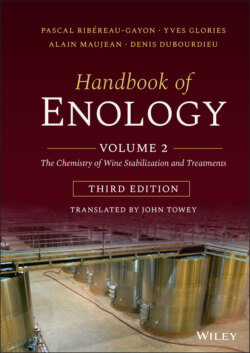Читать книгу Handbook of Enology, Volume 2 - Pascal Ribéreau-Gayon - Страница 70
2.6.3 Lactones
ОглавлениеLactones are formed by an internal esterification reaction between an acid function and an alcohol function in the same molecule. This reaction produces an oxygenated heterocycle.
Volatile lactones, produced during fermentation, are likely to contribute to wine aroma. The best known is γ‐butyrolactone, present in wine at concentrations on the order of a mg/l. This compound results from the lactonization of γ‐hydroxybutyric acid, an unstable molecule produced by deamination and decarboxylation of glutamic acid, according to the Ehrlich reaction (Figures 2.4 and 2.11). It does not seem to play a major role in the organoleptic characteristics of wine. Lactones may also come from grapes, under the action of B. cinerea (e.g. γ‐nonalactone) (Section 7.7) and from oak.
FIGURE 2.12 Formation of sotolon in wines.
Sotolon (4,5‐dimethyl‐3‐hydroxy‐2‐furanone), a highly aromatic compound (Figure 2.12), is also formed during wine aging by the non‐enzymatically catalyzed condensation of α‐ketobutyric acid and acetaldehyde (Section 8.7). It is thus found in Vin Jaune from the Jura region, where it is responsible for the walnut aroma so typical of this wine (Martin et al., 1992), but also in dry and sweet white wines that have gone through oxidative phenomena (Section 8.7).
Lastly, oak releases lactones into wine during barrel aging (Section 13.7.4). The cis and trans isomers of β‐methyl‐γ‐octalactone (Figure 2.13) are known as oak lactones or whisky lactones. The pure compounds have a coconut odor, and when diluted, they are reminiscent of oaky wines. Concentrations in wine are on the order of a few tens of milligrams per liter, considerably higher than the perception threshold (a few tens of micrograms per liter).
FIGURE 2.13 β ‐Methyl‐γ‐octalactone.
